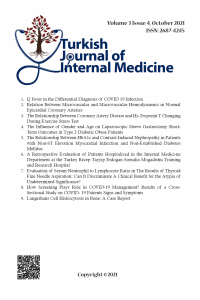Abstract
Supporting Institution
yok
Project Number
yok
References
- WHO COVID-19 Case definition. Available at: https://www.who.int/publications/i/item/WHO-2019-nCoV Surveillance_Case_Definition-2020.2
- COVID-19 Rehberi. Available at: https://covid19.saglik.gov.tr/TR-66301/covid-19-rehberi.html
- Eldin C, Mélenotte C, Mediannikov O, Ghigo E, Million M, Edouard S, et al. From Q Fever to Coxiella burnetii Infection: a Paradigm Change. Clin Microbiol Rev. 2017;30(1):115-90.
- Köksal E, Günal Ö, Kılıç SS. Q fever: An occupational disease. Klimik Derg. 2020; 33(2): 195-6.
- Asan A. KLİMİK 2015 XVII. Türk Klinik Mikrobiyoloji ve İnfeksiyon Hastalıkları Kongresi Kitabı. 2015; 87-8.
- Çelebi B, Baş B, Agüloğlu Bali E, Şimşek Yavuz S. Endokarditli Bir Olgudan Coxiella burnetii’nin Türkiye’de İlk İzolasyonu; Antijen Üretimi ve Faz Değişimi Çalışması. Mikrobiyol Bul. 2019;53(3):274-84. doi: 10.5578/mb.68336
- Coleman JJ, Manavi K, Marson EJ, Botkai AH, Sapey E. COVID-19: to be or not to be; that is the diagnostic question. Postgrad Med J. 2020;96(1137):392-8. doi: 10.1136/postgradmedj-2020-137979.
- Vink M, Vink-Niese A. Could cognitive behavioural therapy be an effective treatment for long COVID and post COVID-19 fatigue syndrome? Lessons from the Qure Study for Q-Fever Fatigue Syndrome. Healthcare (Basel). 2020 Dec 11;8(4):552. doi: 10.3390/healthcare8040552.
- Park HS, Bae PK, Jeong HW, Son BR, Shin KS. Serological evidence of Coxiella burnetii and SARS-CoV-2 co-infection: A case report. Ann Lab Med. 2021;41(5):510-3. doi: 10.3343/alm.2021.41.5.510
Abstract
Coxiella burnetii is an intracellular, Gram-negative bacteria and is the causative agent of Q fever, a zoonosis first described in Australia in 1937. It can cause endemics around the world. People usually get the disease by inhaling the contaminated aerosol produced by infected livestock. Contaminated milk, intradermal inoculation, sexual contact, blood transfusion, and transplacental route may also occur. The infective dose for humans is 1-10 bacteria. It is resistant to environmental conditions and can remain alive in animal wastes such as dust and fertilizer. Acute infection is typically asymptomatic or may manifest as a febrile flu-like illness, pneumonia, hepatitis, and central nervous system (CNS) infection. Q fever outbreaks are often caused by occupational exposure that includes shepherds, animal keepers, veterinarians, slaughterhouses or dairy workers, and laboratory personnel working with C. burnetii. During the course of the disease that cannot be distinguished from other pneumonia clinically; 2-10 fold increase in liver function tests, leukocytosis and thrombocytopenia, erythrocyte sedimentation rate and creatine kinase increase may be observed or laboratory findings may be normal. An immunofluorescent antibody (IFA) test, which is a serological reference method, should be requested from patients suspected for the diagnosis of Q fever.
Keywords
Project Number
yok
References
- WHO COVID-19 Case definition. Available at: https://www.who.int/publications/i/item/WHO-2019-nCoV Surveillance_Case_Definition-2020.2
- COVID-19 Rehberi. Available at: https://covid19.saglik.gov.tr/TR-66301/covid-19-rehberi.html
- Eldin C, Mélenotte C, Mediannikov O, Ghigo E, Million M, Edouard S, et al. From Q Fever to Coxiella burnetii Infection: a Paradigm Change. Clin Microbiol Rev. 2017;30(1):115-90.
- Köksal E, Günal Ö, Kılıç SS. Q fever: An occupational disease. Klimik Derg. 2020; 33(2): 195-6.
- Asan A. KLİMİK 2015 XVII. Türk Klinik Mikrobiyoloji ve İnfeksiyon Hastalıkları Kongresi Kitabı. 2015; 87-8.
- Çelebi B, Baş B, Agüloğlu Bali E, Şimşek Yavuz S. Endokarditli Bir Olgudan Coxiella burnetii’nin Türkiye’de İlk İzolasyonu; Antijen Üretimi ve Faz Değişimi Çalışması. Mikrobiyol Bul. 2019;53(3):274-84. doi: 10.5578/mb.68336
- Coleman JJ, Manavi K, Marson EJ, Botkai AH, Sapey E. COVID-19: to be or not to be; that is the diagnostic question. Postgrad Med J. 2020;96(1137):392-8. doi: 10.1136/postgradmedj-2020-137979.
- Vink M, Vink-Niese A. Could cognitive behavioural therapy be an effective treatment for long COVID and post COVID-19 fatigue syndrome? Lessons from the Qure Study for Q-Fever Fatigue Syndrome. Healthcare (Basel). 2020 Dec 11;8(4):552. doi: 10.3390/healthcare8040552.
- Park HS, Bae PK, Jeong HW, Son BR, Shin KS. Serological evidence of Coxiella burnetii and SARS-CoV-2 co-infection: A case report. Ann Lab Med. 2021;41(5):510-3. doi: 10.3343/alm.2021.41.5.510
Details
| Primary Language | English |
|---|---|
| Subjects | Internal Diseases |
| Journal Section | Letters to the Editor |
| Authors | |
| Project Number | yok |
| Publication Date | October 29, 2021 |
| Submission Date | March 30, 2021 |
| Acceptance Date | June 30, 2021 |
| Published in Issue | Year 2021 Volume: 3 Issue: 4 |
Cited By
Çocuklarda Q ateşi konulu literatürün derlemesi
Pediatric Practice and Research
https://doi.org/10.21765/pprjournal.1203466


